Does exchange arthroplasty of an infected shoulder prosthesis provide better eradication rate and better functional outcome, compared to a permanent spacer or resection arthroplasty? a systematic review
- PMID: 26832360
- PMCID: PMC4735952
- DOI: 10.1186/s12891-016-0901-6
Does exchange arthroplasty of an infected shoulder prosthesis provide better eradication rate and better functional outcome, compared to a permanent spacer or resection arthroplasty? a systematic review
Abstract
Background: The best surgical modality for treating chronic periprosthetic shoulder infections has not been established, with a lack of randomised comparative studies. This systematic review compares the infection eradication rate and functional outcomes after single- or two-stage shoulder exchange arthroplasty, to permanent spacer implant or resection arthroplasty.
Methods: Full-text papers and those with an abstract in English published from January 2000 to June 2014, identified through international databases, such as EMBASE and PubMed, were reviewed. Those reporting the success rate of infection eradication after a single-stage exchange, two-stage exchange, resection arthroplasty or permanent spacer implant, with a minimum follow-up of 6 months and sample size of 5 patients were included.
Results: Eight original articles reporting the results after resection arthroplasty (n = 83), 6 on single-stage exchange (n = 75), 13 on two-stage exchange (n = 142) and 8 papers on permanent spacer (n = 68) were included. The average infection eradication rate was 86.7 % at a mean follow-up of 39.8 months (SD 20.8) after resection arthroplasty, 94.7 % at 46.8 months (SD 17.6) after a single-stage exchange, 90.8 % at 37.9 months (SD 12.8) after two-stage exchange, and 95.6 % at 31.0 months (SD 9.8) following a permanent spacer implant. The difference was not statistically significant (p = 0.650). Regarding functional outcome, patients treated with single-stage exchange had statistically significant better postoperative Constant scores (mean 51, SD 13) than patients undergoing a two-stage exchange (mean 44, SD 9), resection arthroplasty (mean 32, SD 7) or a permanent spacer implant (mean 31, SD 9) (p = 0.029). However, when considering studies comparing pre- and post-operative Constant scores, the difference was not statistically significant.
Conclusion: This systematic review failed to demonstrate a clear difference in infection eradication and functional improvement between all four treatment modalities for established periprosthetic shoulder infection. The relatively low number of patients and the methodological limitations of the studies available point out the need for well designed multi-center trials to further assess the best treatment option of peri-prosthetic shoulder infection.
Figures
References
-
- Jerosch J, Schneppenheim M. Management of infected shoulder replacement. Arch Orthop Trauma Surg. 2003;123:209–14. - PubMed
-
- Jacquot N, Chuinard CH, Boileau P. Results of deep infection after a reverse shoulder arthroplasty. Walch G, Boileau P, Mole D, et al., eds. Reverse shoulder arthroplasty: clinical results, complications, revision. Sauramps Medical 2006:307–12
-
- Seebauer L. Total reverse shoulder arthroplasty: European lessons and future trends. Am J Orthop (Belle Mead NJ) 2007;36(Sup1):22–8. - PubMed
Publication types
MeSH terms
LinkOut - more resources
Full Text Sources
Other Literature Sources


